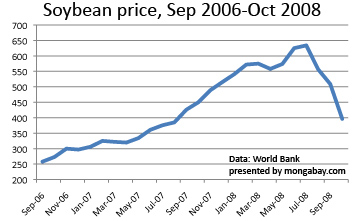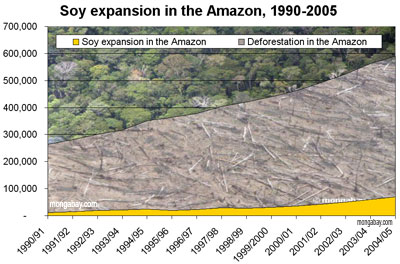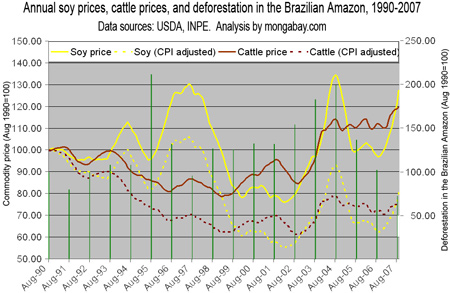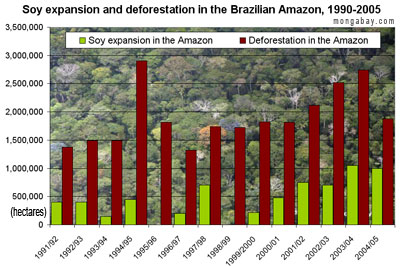Agricultural firms cut incentives for Amazon deforestation
Rhett A. Butler, mongabay.com
December 2, 2008
|
|
As grain prices plummet and concerns over cash mount, agricultural giants are cutting loans to Brazilian farmers, reports the Wall Street Journal. Tighter farm credit may be contributing to a recent slowing in deforestation in the Brazilian Amazon, where agriculture is an increasingly important driver of forest clearing.
According to the Wall Street Journal, a weakening global economy is making it more difficult for Brazilian farmers to get loans to cover the cost of fertilizers, pesticides and seed as well as finance capital equipment. The development is an abrupt turn from Brazil’s agricultural boom, which saw rapid expansion of soy, corn, cotton, and cane plantings, and turned the country into the world’s largest exporter of many farm products.
“In the past several years, amid surging global demand for grain, farmers plowed up land at a feverish pace to plant soybeans, and roads were carved into the countryside to move the goods. Climbing grain prices through the first half of 2008 accelerated the growth,” writes Lauren Etter.
 Soybean prices, Sep 2006-Oct 2008 |
Now strapped for cash and facing rising risks in the credit markets, agricultural firms including Archer-Daniels-Midland Co., Bunge Ltd. and Cargill Inc., and equipment suppliers like Deere & Co. are reducing loans and advance cash payments to farmers at a time when production and borrowing costs are rising.
“As the volatile commodities market and the global financial crisis have increased the risk and expense of doing business in Brazil, big grain companies are reining in lending,” writes Etter.
“Unlike in the U.S., where farmers depend on loans from private banks and the government, Brazilian farmers get as much as 40% of their financing from agriculture companies. That could drop to as low as 25% this year, according to M.V. Pratini de Moraes, a former Brazil agriculture secretary.”
Higher costs and lower prices could temper farmers’ ambitions to expand their holdings, reducing incentives to clear new land for production. The U.S. Agriculture Department forecasts a 2 percent drop in Brazilian soybean production for the 2008-2009 crop year.
Soy in the Amazon
 Soy expansion in the Brazilian Amazon, 1990-2005 Total deforestation and area of soybean cultivation across states in the Brazilian Amazon. Overall soybean cultivation makes up only a small portion of deforestation, though its role is accelerating. Further, soybean expansion and the associated infrastructure development and farmer displacement is driving deforestation by other actors. Note: some soybean farms are established on already degraded rainforest lands and neighboring cerrado ecosystems. Therefore it would be inappropriate to assume the area of soybean planting represents its actual role in deforestation. |
Soybean cultivation in the Amazon has expanded rapidly in recent years due to improved infrastructure in the region and rising demand for vegetable oils for food, industrial uses, and biodiesel production. While the Amazon’s largest soy crushers have had a ban on soy produced from newly deforested lands sine July 2006, soy is nonetheless seen as an important indirect driver of deforestation in the Brazilian Amazon by driving up land prices and creating an impetus for infrastructure improvements that promote forest clearing. In areas where soils and topography are suitable for mechanized soy cultivation, rainforest lands are typically cleared for low-intensity cattle ranching then sold to soy producers some two to three years later. Ranchers then move into frontier areas, spurring deforestation.
As more Amazon land has come under agricultural cultivation, rising prices for commodities have served as an impetus for forest clearing. Expansion in the region has been promoted both by financial incentives — including subsidized loans — and Brazil’s ambitious $43 billion “Program for the Acceleration of Growth” (PAC), an initiative that is funding construction of roads, ports, pipelines, hydroelectric dams, and other infrastructure improvements. Under the PAC, large areas of the Amazon will be opened to development, improving the viability of soy, oil palm, logging, and beef production in once remote areas.

|
REFERENCES
- LAUREN ETTER. In Brazil, Credit to Farmers Dries Up. Wall Street Journal 30 Nov 2008.
- RHETT A. BUTLER. Future threats to the Amazon rainforest. Mongabay.com 31 Jul 2008
- RHETT A. BUTLER. 2007 Amazon fires among worst ever. Mongabay.com 22 Oct 2007
